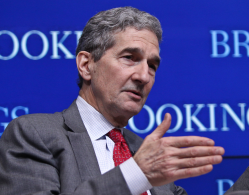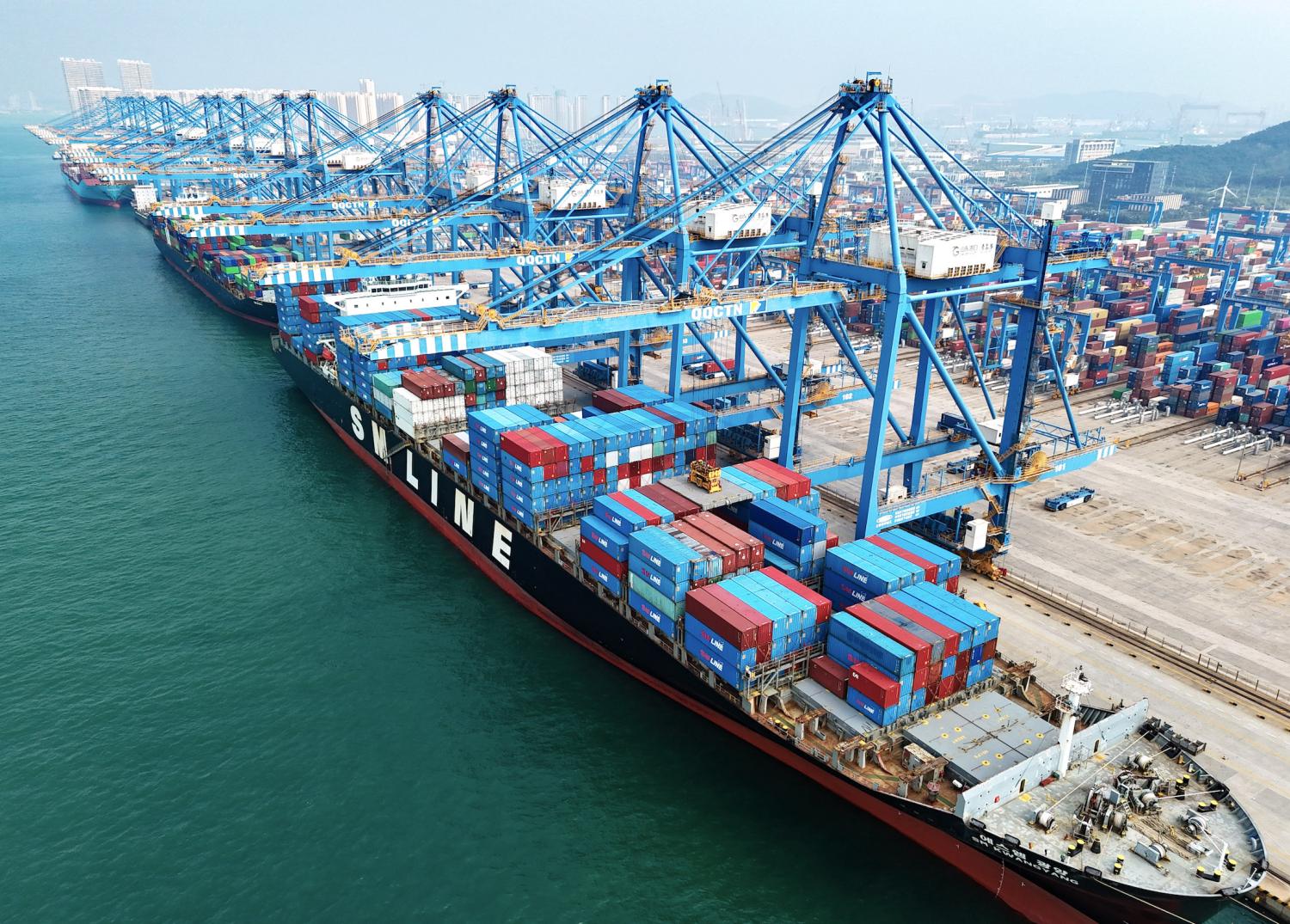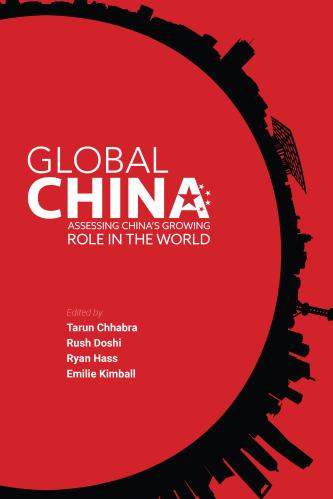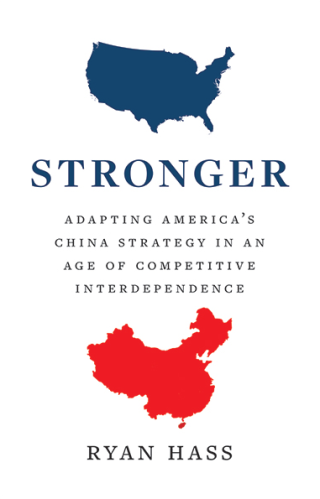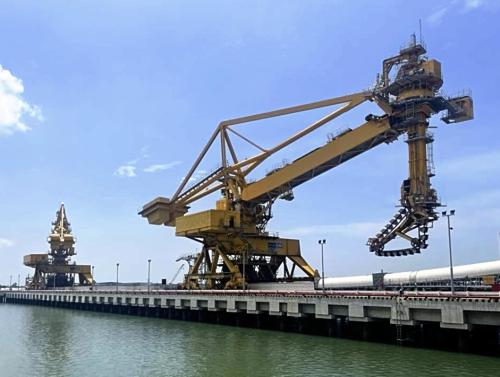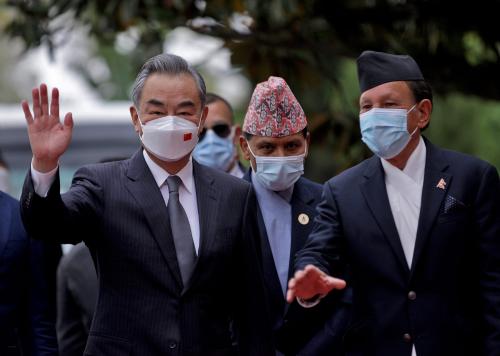In this written debate, the authors address the title question with essay-length opening statements. The statements are followed by an interactive series of exchanges between authors on each other’s arguments. The goal of this product is not to reach any conclusion on the question, but to offer a rigorous examination of the choices and trade-offs that confront the United States in its competition with China. To see the authors debate the question further, please see the October 4 public event on this topic.
The Biden administration’s National Security Strategy identifies China as “the only competitor with both the intent to reshape the international order and, increasingly, the economic, diplomatic, military, and technological power to do it.” Given this assumption, does China’s continued economic growth present an intolerable risk to America’s national security? Should the United States seek to limit China’s economic growth in order to protect itself? Is it possible for the United States to champion both free and open markets while placing sweeping limitations on a rival state’s access to goods and services? What kind of limits should Washington place on trade with China to protect U.S. national interests?
To answer these questions and articulate the policy choices U.S. policymakers are facing, Ryan Hass, Patricia M. Kim and Emilie Kimball, co-leads of the Brookings Foreign Policy project: “Global China: Assessing China’s Growing Role in the World,” convened a group of leading experts — Cameron F. Kerry, Mary E. Lovely, Pavneet Singh, and Liza Tobin — to engage in a written debate examining how the United States should manage its economic relationship with China. Their opening statements and reactions follow below:
Target China’s tactics, not its growth
It is not the People’s Republic of China’s (PRC) economic growth, per se, that poses a risk to U.S. national security, but rather the zero-sum means by which the regime in Beijing continues to achieve that growth, as well as the autocratic end goals that growth facilitates.
A better question would be framed in terms of U.S. interests, not rival nation outcomes: should the United States undertake policies to protect its interests, even when doing so slows down GDP growth in China? Here, the answer is clearly yes. The PRC’s brute force economics — an analytic frame I use to describe the evolving set of tactics Beijing uses to bolster the wealth and power of the Chinese state and its national champions at the expense of rival nations and firms — poses intolerable risks to U.S. interests by creating dangerous supply chain dependencies and undermining innovation. These tactics, deployed on a vast scale and scope, also undermine the principles of market competition and transparency the United States advocates with its democratic allies and partners. Consequently, U.S. policymakers must actively defend against these tactics.
Distinguishing between economic growth and the means for achieving it is important for at least two reasons: 1) getting the message right and 2) ensuring strategic focus.
First, targeting PRC behavior (means/tactics) rather than outcomes (growth) insulates the United States from misplaced criticism. Making slower PRC growth an explicit U.S. policy objective invites unhelpful narratives that assign too much agency — and blame — to Washington.
The PRC’s current economic malaise is a product of Beijing’s failure, over many years, to undertake well-understood but politically difficult reforms. While U.S. policies aimed at countering PRC brute force economic tactics — such as tariffs, enhanced investment screening, and export controls — have inflicted economic pain, these moves merely accelerated a long-term PRC slowdown that was underway long before the U.S. shift toward strategic competition in 2017. China’s economic woes are rooted in structural factors and self-inflicted wounds, such as a shrinking population, massive debt accumulated from a multiyear investment binge, and avoidance of necessary fiscal and financial reforms.
This distinction is key when it comes to explaining U.S. policies to domestic audiences, allies, and partners, whose support is essential if the United States hopes to sustain strategic focus. The message will be lost on Beijing, however. Chinese Communist Party (CCP) propagandists will seize the opportunity to blame U.S. policies for China’s economic problems, regardless of U.S. messaging. Even during the engagement era, when U.S. policy explicitly aimed to help China grow sustainably, Beijing harbored deep skepticism of U.S. intentions. Now that the United States has shifted to strategic competition, verbal assurances that Washington does not seek to contain China or stifle its economic progress will not only fail to persuade Beijing but may even be counterproductive: repeating the CCP’s false narratives, even to dispel them, reinforces them in listeners’ minds around the world.
The best Washington can do in messaging its policies to Chinese audiences is to combine long-term optimism with near-term realism, to the effect of: “A free, peaceful, and prosperous China would be the best possible outcome for the people of China, the United States, and the rest of the world. We continue to hope for that future, but at present, the CCP is moving China in the opposite direction, giving us no choice but to protect ourselves and push back against its economic aggression.”
Second, the distinction between PRC growth and tactics is important so that U.S. policies will have a clear strategic focus and can be assessed for effectiveness. Blurring this distinction raises the risk that the United States will abandon pushback policies too soon. If slower PRC growth were the policy objective, U.S. policymakers would be susceptible to prematurely declaring victory, or downshifting their sense of urgency, as economic conditions in China deteriorate further.
It would be dangerous for Washington to assume that slower growth in China will translate into quick U.S. wins in their military and techno-industrial rivalry. China’s economic malaise offers some benefits for the United States, such as lower inflation and an acceleration of the geopolitical trends driving companies to “de-risk” that will in turn provide a shot in the arm for U.S. and allied reshoring and friendshoring efforts. However, it will not immediately force Beijing to grapple with new guns-versus-butter tradeoffs.
In theory, slower growth means fewer resources for Beijing to plow into its military and techno-industrial programs. But in practice, these resource constraints could take years to manifest in a downsized challenge for Washington.
In theory, slower growth means fewer resources for Beijing to plow into its military and techno-industrial programs. But in practice, these resource constraints could take years to manifest in a downsized challenge for Washington. Even at very low rates of annual growth, China’s economy is already very large and, therefore, its outlays for military modernization and technological development, although significant in gross terms, account for a modest percentage of its GDP. Take PRC military spending as an example: though probably much higher than Beijing’s official numbers suggest, even high estimates amount to less than 4% of China’s GDP — far less than Soviet military spending at its height. This is not enough to bankrupt the regime or even impose serious constraints on military modernization anytime soon. As an autocracy, the PRC can continue to direct resources to military and techno-industrial priorities at the expense of funding for the social safety net and other programs that would boost household welfare and rebalance the economy.
Rather than aiming for the vague objective of slowing China’s growth, U.S. policymakers should pursue two specific goals regarding Chinese tactics: degrading China’s military and technological capabilities and countering its anticompetitive and coercive economic tactics. Fear that these policies will result in slower GDP growth in China should not hold Washington back. Slower PRC growth should already be baked into every policymaker and business leader’s calculus. The strategic importance of taking a strong stand against PRC brute force economics — and rallying allies and partners to pool their domestic market demand to counter the gravitational pull of the China market — outweighs the additional economic pain that those policies could cause on the margins.
Orienting to compete
There are many unknowns surrounding China’s economic trajectory and the path it will follow in the coming years. Irrespective of this uncertainty, leaders in the United States must recognize that China’s strategic intent to “catch up and surpass” the United States as the world’s economic and technological superpower presents significant risks to the U.S. national interest. This is especially the case in light of three factors. First, the global economy is undergoing an industrial revolution headlined by rapid, simultaneous advances in emerging technologies. Second, the PRC is executing a multi-decade, whole-of-nation strategy to achieve primacy in future technologies. Finally, while the United States has initiated a response, in order to prevail in this techno-industrial competition, it must significantly increase and coordinate its investment in American strengths, correct existing economic and financial misalignments, and experiment with new tools that address the dynamic challenge from China.
The unique technological moment is the linchpin for the entire competition. In previous decades, the United States was the first to achieve dominance in miniaturized electronics, the internet, GPS, and software capabilities which ultimately delivered outsized economic, political, and military influence. Today, overlapping progress in artificial intelligence, biotechnology, quantum information sciences, cyber, and space systems are similarly primed to alter the geoeconomic landscape. Geopolitical powers are sponsoring indigenous capability and the race for technological and economic leadership is now a central geostrategic battleground. Nations that lead in the resulting industries will govern decades of economic exchanges, reap commercial benefits, and develop military advantage.
China is singularly focused on the importance of technology leadership. Beijing is executing a multi-decade plan to transfer technology to increase the size and value-add of its economy, increase its research and development (R&D) intensity, and mobilize academia, business, and the government behind grand-scale technology innovations such as quantum communications, genetic engineering, high-resolution Earth observation, and manned space flight, among others. In this pursuit, Beijing is employing a range of mercantilist trading policies to overwhelming advantage, augmented by a full spectrum of licit and illicit transfer of intellectual property. Additionally, through its industrial policy, China prioritizes import substitution which, if successful, will transfer global market leadership to China in many markets such as semiconductors, computer hardware and software, networking and communications, automobiles, and genetic engineering.
Internationally, China is expanding its economic sphere of influence through the Belt and Road Initiative (BRI), which is opening markets for Chinese goods and companies. Nested within the BRI is the Digital Silk Road (DSR), which creates a technology infrastructure to support economic development and power projection. Through a network of cross-border fiber optic cables, coupled with remote sensing, communications, and other satellite services, the DSR aims to enable everything from e-commerce to smart cities, significantly shaped by Chinese companies and interests.
Over the coming years, the United States will need to make sizeable investments and intensify coordination to accomplish its strategic goals.
Fortunately, there is bipartisan awareness of the challenges China presents. Leaders in successive administrations introduced meaningful defensive interventions such as sanctions, inbound and outbound investment restrictions, tariffs, and export controls and offensive interventions such as investments in microelectronics and clean energy. Moreover, there is broad agreement at a policy level on discrete technologies that will dictate future competitiveness. These actions are only the start. Over the coming years, the United States will need to make sizeable investments and intensify coordination to accomplish its strategic goals.
The first step is to bolster the ingredients that historically powered U.S. economic strength. Based on the recognition that basic science is the seed for future innovations, the United States should increase federally-funded R&D to at least 2% of GDP, up from less than 1% today. Further, policymakers need to be serious about building a STEM talent pipeline for the future workforce. This implies investing in science, technology, engineering, and mathematics education today, particularly at the K-12 level. Finally, to lead in research and development and to be able to translate prototypes into manufactured products at scale, the United States needs workers with talent at all levels. This implies developing and executing an immigration policy that welcomes a balance of high-skilled and low-skilled immigrants.
To further optimize these efforts, policymakers must correct policy and regulatory misalignments that prevent private actors from investing in and commercializing critical technologies. Two prominent areas that merit scrutiny include the short-term bias in U.S. capital markets and the lack of a trade and investment policy to match trends in technology development.
Currently, U.S. corporations focus on return on capital at the expense of long-term R&D and technology development. A combination of quarterly-earnings pressure and the increased power of activist shareholders shifted corporate attention to short-term profits and capital efficiency rather than balancing these goals with investments for long-term capability development. To strike the right balance, U.S. firms do not have to abandon their market instincts. There are a range of proposals on how to influence financial incentives, extend investment horizons and promote capability development. These include reforming capital gains tax provisions, creating dual-class shares with sunset provisions, enforcing mandatory holding periods, or increasing R&D tax credits. Given the criticality of the private sector in this competition, finding a workable solution amongst policymakers, corporate leaders, employees, and shareholders is an urgent priority.
Similarly, the United States needs a coherent market access policy to ensure that U.S. companies are able to compete globally. Currently, firms are disadvantaged in foreign markets — partly because of U.S. legal constraints governing business practices and partly because they are competing against firms supported by various state-backed mechanisms. Since withdrawing from the Trans-Pacific Partnership, the United States has not created a forward-looking trade arrangement and it is not yet clear whether the Indo-Pacific Economic Framework will create the market access, investment opportunities, and enduring revenue opportunities that firms require to take on riskier technological investments. Rationalizing U.S. policy on trade is essential to preventing public investments from going to waste.
Officials can also experiment with different resources that are relevant to the current domains of competition. One concept worth exploring is informally referred to as the National Capital Stack. While much has been made of the formidable $1.5 trillion of patient capital that China is deploying against deep technologies, the U.S. government has a more robust capability to de-risk investment and activate the animal spirits of the U.S. capital markets. To date, the tools, resources, and authorities are dispersed across various departments and are deployed more as point solutions rather than being combined to take technologies to scale. Recently, however, the Department of Energy (DOE) has demonstrated a pipeline for companies to leverage DOE grants, loans, insurance and tax credits to advance costly energy projects. Similarly, the Defense Innovation Unit and the newly created Office of Strategic Capital at the Defense Department are contemplating tools to catalyze entrepreneurs to take on challenges relevant to national security. This activity could be comprehensively applied across the government, to include tools from Agriculture, Homeland Security, Commerce, Small Business Administration, the Export-Import Bank, and NASA at a minimum. Cohering non-dilutive R&D grants and loans with advance market commitments and procurement capability would signal to the private sector that the government can be a constructive partner at every stage of the technology development cycle.
China’s strategic intent is clear. The PRC seeks to displace the United States economically and technologically, which will have significant ramifications for international rules and norms, military positioning, and ideological competition. The pace and confluence of technology development and resulting economics make the risk of displacement viable. Regardless of China’s economic growth or decline, the United States needs to adequately prepare for a multigenerational techno-industrial contest with a rival. The good news is that the United States has the necessary expertise, resources, and tools resident throughout society. The key will be whether U.S. leaders can orient these endowments to compete.
Precision, not panic: A measured response to China’s growth
A China strategy aimed at keeping China down would be reckless and destined to fail. Perhaps catastrophically. Complete uncoupling from China is neither desirable nor possible. China’s military build-up, its aggressiveness in the South China Sea and elsewhere, and its market distortions and repressive policies at home present a number of challenges to the United States and a rules-based international order, and the United States needs to meet these, but in more measured ways.
The most existential such challenge is the risk of armed conflict over Taiwan or other spheres where China sees its “core interests” at stake. The United States must prepare for this contingency — but also act wisely to mitigate it. Acting broadly to block China’s rise might diminish its economic power but would inflame its nationalist and adventurist impulses — marching headlong into the “Thucydides trap” that Graham Allison sees as leading to conflict between a rising power and a diminishing one.
Diminishing China’s economy also has a cost for the United States and its allies. As the largest trading partner of many U.S. allies, with 18.1% of the global economy and $3.36 trillion in trade, China adds to global prosperity. Even in the United States, especially for critical supplies, supply chains remain entangled. So do ecosystems of research and development in critical reduces imports from China technologies. A Brookings report I co-wrote early this year documented the extent to which, even as the United States and China compete in artificial intelligence (AI), they remain each other’s largest collaborators; it also showed how Chinese researchers contribute to AI R&D in the United States through publications and employment in U.S. companies. We are linked together as partners and not just competitors.
The time when the United States alone had the power to shape the trajectory of Chinese economic growth is long past.
The time when the United States alone had the power to shape the trajectory of Chinese economic growth is long past. Even in narrow markets like advanced microchips, it takes a combination of Taiwanese and Dutch manufacturing capacity alongside U.S. design to establish effective limits. Furthermore, such advantages are rare and, as with most export controls, apt to be temporary as China ramps up its indigenous capacity and finds alternative sources of supply, as questions about whether Huawei has managed to produce advanced chips for smartphones underscore. Indeed, China has proved more strategic than the United States in protecting its foreign and domestic sources of supplies critical to its economy and merging technologies.
In sum, advocates of full-scale decoupling should be careful what they wish for. The relationship with China is simply too complex for a wholesale black-and-white policy.
The U.S. approach toward China must differentiate China’s rise and status from concrete concerns with the policies and conduct of the Chinese government and ruling party — retail shades of gray, if you will. The rhetoric and the measures should take clear aim at identified and fact-based concerns about human rights, trade barriers, supply chain security, and military implications. To succeed, these measures will need to be established iteratively through thoughtful investigation and active engagement with stakeholders involved and international partners.
In 2010, I co-led the drafting of a memorandum from Commerce Secretary Gary Locke to President Barack Obama calling for a more reciprocal attitude to China’s “one-sided market.” The memo proposed that the United States needed to “demonstrate to the Chinese that there will be consequences” for its unequal treatment of U.S. firms compared to Chinese ones.
The Trump administration got right the part about reciprocity and one-sidedness in the relationship. But it responded with a blunderbuss where a sharpshooter’s rifle was needed. Its rhetoric was heavy on broad-brush denunciation of China (for example, Secretary of State Mike Pompeo declaring that “[s]ecuring our freedoms from the Chinese Communist Party is the mission of our time”). Its policy response was based almost entirely on an array of tariffs, leading to three years of negotiations to ease some tariffs on both sides and an agreement by China to increase some agricultural imports from the United States. A “China initiative” aimed at industrial espionage, which investigated numerous Chinese and Chinese-surnamed researchers; several of whom were acquitted or saw charges dismissed, and imprecations about the “Chinese virus” conveyed hostility to all things Chinese rather specific policies and conduct. As Bob Davis and Lingling Wei recount, this posture caused negotiations over market-opening changes to founder because of the Chinese government’s belief that the changes were aimed at undermining the Chinese economy and the CCP regime.
The Biden administration has not taken a sharply different course. Although export controls on advanced microchips a year ago were narrowly targeted, National Security Adviser Jake Sullivan’s descriptions of the goal to “maintain as large a lead as possible” and of export controls as “a new strategic asset” were widely understood as aimed at the bigger target of China’s growth and development. The administration has also left tariffs in place. Since then, however, the administration has articulated a more subtle and focused approach.
A meeting between President Joe Biden and Chinese President Xi Jinping in Bali last November opened the door to increased engagement and fuller statements of policy by members of the Biden cabinet. Treasury Secretary Janet Yellen led off with an April speech on the U.S.-China economic relationship in which she affirmed that “[a] decoupling of the world’s two largest economies would be destabilizing for the global economy, and it would be virtually impossible to undertake.” At a Brookings event on the U.S. international economic agenda not long afterward, Sullivan clarified what he had meant by a “small yard and high fence” when he described export controls, saying that “we are for de-risking and diversifying, not decoupling,” with a hat-tip to European Commission President Ursula von der Leyen for the formulation.” In May, Secretary of State Antony Blinken summarized the administration’s view of China as “the most serious long-term challenge to the international order” while affirming that “[w]e don’t seek to block China from its role as a major power…” Both Yellen and Blinken traveled to China this summer and were cordially received (including a Blinken meeting with Xi) and delivered public speeches.
The Biden administration is having the kind of pointed discussion with China that is needed. It is being clear about drawing specific differences with China’s increasingly hegemonic conduct and policies on human rights and market access and attaching consequences. It also being clear about sustaining an economic relationship; notwithstanding critics of the term “de-risking,” risk management provides a useful frame for articulating the targeted objectives of the United States and its allies in relation to China. A targeted approach is better calculated to get results than a sweeping one because it offers greater moral clarity and is more sustainable and manageable.
The Biden administration’s sharpest departure from its predecessor has been its focus on enlisting allies and acting in concert through common policies and networks for trade or security. This direction is essential. As with export controls on chips, other limitations on exports or investment, the pursuit of trade remedies (including targeted tariffs), and the development of new sources of supply for critical resources will be far more effective if they are joined not only by other democracies but also other large economies.
The leaders of the United States and China both recognize that the course of their relations will have a profound effect on the course of world history — on the world’s prosperity, its technological and social advancement, its climate, and its continuity. Managing this relationship requires holding competing imperatives in mind — and on the table — at one time. That’s not simple.
China has not made it easy, either. It has gone from Zhou Enlai, Henry’s Kissinger’s counterpart in the 1972 opening who articulated the following outlook in 1955, “seeking common ground while shelving differences,” to resisting discussions of common concerns as a response to broader tensions. For this reason, it has been unwilling to resume military contacts or engage on climate targets. The Chinese Wolf Warriors are fond of blunderbusses too. Rather than escalate, the United States should move forward steadily, seeking common ground and calling out differences with targeted precision.
Seeking to limit China’s growth weakens the United States
In recent months, the Biden administration’s two top economic officials, Commerce Secretary Gina Raimondo and Treasury Secretary Janet Yellen, visited Beijing in an attempt to stabilize the troubled U.S.-China economic relationship. Both made clear that the United States does not seek to decouple or weaken the Chinese economy. Rather, both emphasized the benefits of fair competition and the potential for fruitful cooperation.
These efforts to reduce bilateral tensions have been criticized by those who see China as intent on displacing U.S. economic and technical leadership. Through this lens, Chinese behavior is an intolerable threat to U.S. security. Instead of engagement, this view calls for a whole-of-government effort to deter Chinese actions and, in the extreme, to hinder Chinese growth. In my view, this approach mistakes Chinese weakness for U.S. strength. Rather than seeking to weaken China, the United States should defend its rightful interests by explicitly identifying harmful practices and pursuing solutions narrowly targeted at these practices. Recent efforts to counter Chinese actions show that a targeted approach rallies allies to support and amplify U.S. actions, while efforts to unilaterally force change in China are ineffective and costly to the United States.
Undoubtedly, some Chinese actions and ambitions pose serious national security concerns for the United States. Over the past five years, the United States has used trade tools to reduce two such threats: the ability of the Chinese military to access advanced semiconductors made with American technology and forced technology transfer. The U.S. approach to countering these threats illustrates the benefits and challenges of designing narrowly targeted responses to harmful Chinese practices.
Clearly, the denial of access to key U.S. technologies aligns with national security concerns about Chinese military modernization and upgrading. The Biden administration has pursued a policy dubbed “small yard, high fence” to identify technologies where U.S. denial of access can be effective yet limited in scope. The so-called October 7 controls restrict exports of advanced semiconductors needed for artificial intelligence and supercomputing and impose limits on the use of U.S. equipment, software, and expertise needed to make advanced chips in China.
These restrictions have gained support from two countries central to Chinese development of advanced chips, the Netherlands and Japan. The United States has been clear on their intent and transparent about their deployment. While there have been complaints that the October 7 controls cover too much technology (e.g., certain memory chips), their targeted design and clear rationale have helped gain allied support, and, thus, are key to their effectiveness. Proposed rules for screening outbound investment follow a similar playbook – identify specific risks from commercial exchanges with China and target policies accordingly. This approach aligns with that endorsed by the European Commission, which frames its defensive trade strategies around the principles of “proportionality” and “precision,” aiming to limit unintended spill-over effects from its actions.
In contrast to carefully crafted export and investment controls, however, the Biden administration has retained Trump-era import tariffs that are neither targeted nor restrained. Average U.S. tariffs on Chinese exports exceed 19% and cover over 66% of imports. Products of no strategic value to U.S. national security are among those covered by these import taxes, including intermediate inputs used by American manufacturers and toys, clothes, and household sundries bought by American families.
Whatever the reason for the Biden administration’s maintenance of the trade-war tariffs, they have had the effect of eroding the U.S.-China commercial relationship. In the 12 months preceding July 2023, the United States imported its smallest share of goods from China in 17 years. Since 2020, once-robust bilateral investment flows have diminished, with the American share of both direct and portfolio investment into China falling. High U.S. tariffs, plus heightened uncertainty about the future of U.S.-China relations, are accelerating the movement of electronics, textiles and apparel, toys, footwear, and other labor-intensive activities to alternative locations.
This tax-induced reduction in imports from China has been costly for U.S. consumers and businesses. To date, the U.S. Customs and Border Protection has collected $192 billion in tariff revenue from imports taxed by the trade war, an amount largely borne by American businesses and consumers. One effect of this burden is reduced competitiveness of U.S. exporters who rely on imported Chinese intermediates. A detailed study of firm import and export patterns estimates that the burden on affected firms is equivalent to new duties of $900 per worker. The trade war shows how costly it would be to further reduce U.S. imports from China using higher tariff rates.
Given the cost to American interests, we might ask how effective the trade war was in changing Chinese practices. The evidence suggests some changes were made, but there was no resolution of major American grievances. China promised improvements to its intellectual property protection regime, and did complete changes that were already underway, such as the creation of new appellate intellectual property courts and opening its market for some financial services. However, forced and illicit technology transfer is reportedly still taking place. China made none of the additional purchases of U.S. exports promised in the Phase 1 agreement signed by the Trump administration in January 2020.
U.S. tariffs did cause problems for Chinese exporters tied to U.S. customers, just as Chinese retaliatory tariffs on U.S. exports disrupted mainland supplies of grain, meat, energy, and medical products. But China’s share of world exports did not fall and, with exports accounting for less than 3% of Chinese manufacturing output, the U.S. trade war had little effect on Chinese GDP. No other country joined the U.S. effort to punish China by raising tariffs. Indeed, most gained better access to the Chinese market by decreases in the average tariff China charged non-American exporters.
Perhaps the most harmful spillover from the trade war is that it eroded America’s reputation as a reliable commercial partner.
Perhaps the most harmful spillover from the trade war is that it eroded America’s reputation as a reliable commercial partner. Tariffs imposed by both the United States and China have been found to violate World Trade Organization (WTO) rules. U.S. actions that clearly violate WTO commitments to nondiscrimination signal a willingness to bend or break rules upon which smaller countries depend. This uncertainty clouds U.S. efforts to court low and middle-income countries in the Indo-Pacific and the Americas as alternative sites for production. China is the most important trade partner for almost all countries joining the United States in the Indo-Pacific Economic Framework (IPEF) negotiations, with 11 of these 13 countries already bound to China through a preferential trade agreement. Indeed, a recent study of IPEF-country trade patterns reveals that even as most have grown more reliant on imports from China, many have increased the share of exports going to both the United States and China. Continued access to both markets is a central goal for the region and U.S. efforts to rally them to weaken China would be met with defiance.
The rest of the world is not blind to Chinese aggression. The United States led the construction of a rules-based system centered on the WTO, one accommodative of domestic laws that promote fair trade and deflect harmful trade practices. The United States used such domestic law in its Section 301 case against Chinese intellectual property and technology transfer practices. Unfortunately, the Trump administration chose to blanket bilateral trade flows with high tariffs while seeking preferential access to the Chinese market rather than identify and target trade flows disrupted by unfair Chinese practices. We can never know what might have happened, but if the United States had maintained its focus on intellectual property theft and designed its tariffs in a corresponding fashion, other countries might have also undertaken actions to rebuke Chinese actions.
We would be wise to heed Yellen’s words of warning: U.S. efforts to limit China’s growth would be destabilizing and, ultimately, futile. The United States secures its own future when it responds to coercive tactics with policies that are targeted, transparent, and respectful of the rules-based norms on which our friends and allies rely.
Author responses to opening statements
Liza Tobin
Rather than eliciting an explicit “yes,” the prompt that Brookings presented revealed differences in how each participant perceives the risk of U.S. policy veering to one extreme or the other: too assertive or too cautious.
Kerry and Lovely argued that attempts to curtail China’s growth would be reckless and potentially catastrophic, although they don’t specify which concrete policies would have particularly dire consequences. On the other side, Singh and I contend that Beijing’s pursuit of its techno-economic ambitions, rather than its growth per se, poses an intolerable risk to U.S. national interests. We both advocate for more robust competitive policies, irrespective of their impact on China’s GDP (something all four essays acknowledge is mostly out of U.S. control anyway). Among the four essays, Singh offers the most comprehensive set of policy options, calling for “orders of magnitude of more investment and coordination to accomplish [U.S.] strategic goals.” He rightfully redirects the discussion from the red herring of China’s GDP growth to what the United States must do to protect and promote its own interests.
Singh’s essay underscores a welcome development in policymaking circles: a renewed recognition that production and innovation are linked, and that decades of outsourcing has severed this link in the United States. Innovation often occurs as a result of production itself (“learning by doing”), and when firms shift production capacity overseas, domestic innovative capacity and workforce skills are diminished over time. China, meanwhile, diligently mastered “process innovation,” aided by mercantilist policies that sidelined foreign competition. Excessive supply chain dependence on China endangers America’s strength in process innovation. Long-term prosperity hinges on rebuilding it.
There is already growing consensus on the need for “promote” and “protect” policies in America’s China policy. But there is a crucial third element that should be incorporated; let’s call it “pooling market demand.” This entails a deliberate effort to shift market demand for advanced technology products toward allies and partners and away from China. Admittedly, this is a “second best” option from an economic efficiency perspective, but China’s extensive track record of unfair practices, and the WTO’s inability to discipline them, have rendered the “first best” option — multilateral free trade involving China — untenable. Further work is needed to design effective measures to deepen integration with partner nations that already have extensive trade links to China, while not inadvertently increasing exposure to China. Lovely correctly highlights Indo-Pacific nations’ importance in this regard. Ultimately, our focus isn’t on slowing China’s economic growth but on rebuilding productive capacity in the United States and other market economies.
Pavneet Singh
There seems to be broad consensus amongst my fellow contributors that the U.S. government needs to execute economic policies that are focused, nuanced, and messaged correctly. I agree that some of the actions taken thus far lack clear policy objectives or fail to contemplate second-order vulnerabilities as in the case of rushing to diversify supply chains.
Where I see disagreement is in recognizing the full scope and intentions motivating China’s economic strategy and whether the U.S. response thus far has been designed to limit China’s economic growth. On the former, I believe that we currently lack a shared national understanding of China’s intentions, its scale, and the implications of its potential success. The United States’ ability to shape norms, values, and the rule of law in future intersocietal relations is at stake. On the latter, I do not believe U.S. policy is currently, nor has it ever been designed with the explicit purpose of, stifling China’s economic growth. Instead, what we are witnessing is the U.S. government attempting to shape the behavior of a determined competitor with economic tools that are ill-suited to the current environment.
And while the United States and China may be in competition, this should not preclude collaboration on pressing topics such as climate change and nuclear security or on the more proximate challenge confronting both countries with respect to the future of work and managing the disruption to the workforce from automation. Now is the time to emphasize bilateral and multilateral engagement to ensure that we find durable global solutions.
The fault lines in this conversation, however, do raise two serious questions for policymakers to consider.
First, is whether the United States needs a national security economic strategy (NSES) akin to a national defense strategy or national security strategy. Through an NSES, the United States could outline the economic environment it seeks and what it is prepared to do to ensure that outcome. Such a strategy would drive focus amongst the various economic, financial, and trade agencies, and create alignment within the national security agencies to leverage and create instruments relevant to the global economic realities of today. It would also force tough decisions and tradeoffs for our domestic economy as policymakers integrate national security goals into economic policymaking.
Second, and perhaps more ambitiously, is the question of whether the current international economic system is still appropriate for economic, technological, and strategic realities. Addressing this would allow the United States and other relevant parties to replace or retrofit the current Bretton Woods system to better reflect the changing role of new and existing actors, as well as to modernize the rules of economic exchanges.
Gaining clarity on these two questions will provide much greater focus in the U.S. relationship with China.
Cameron F. Kerry
Regardless of whether one describes America’s posture toward China as de-risking or decoupling, it is a fact that trade between the United States and China has been diminishing. This is less the result of a tariff war than of business conditions in China. Indeed, from the time the Trump tariffs began in 2018 until 2022, U.S. imports from China actually increased. As China’s growth has slowed and its policies have ratcheted from what I called a “one-sided market” in 2010 to what Tobin calls “brute force economic tactics,” it has become a less attractive place to do business.
Even in times of double-digit growth and greater receptivity to foreign-invested companies, China presented what I described as the dilemma of expanding bottom line with declining market share: a market in which companies could earn growing returns but at the price of increasing competition from Chinese firms that were not only enterprising but also often benefitting from copying their intellectual property, adopting their business models, or profiting from government policies and subsidies. Now state control has ramped up further and, with less upside, the downsides loom much larger. The marketplace itself is de-risking.
The contributions above underscore that tariffs are blunt instruments, and each contributor points to alternatives that would aim more precisely at policies and threats to the interests of the United States and its allies. Even Singh, who sees competition with China in perhaps the starkest terms, nonetheless focuses above all on energizing U.S. investment and innovation rather than on weakening China. My co-contributors all point in one way or another to U.S. engagement in trade relationships as a way to respond to China, and the history of export controls shows that measures aimed at China’s policies and conduct are likely to be ineffective and costly unless they are applied in concert with allies.
Mary E. Lovely
Two points of agreement stand out across the four essays: first, each author elevates actions that promote U.S. interests above those that weaken the Chinese economy; second, each author welcomes an increasingly targeted U.S. response to harmful PRC behavior. There is, however, a marked contrast in the importance each author attaches to Chinese motivations and ambitions, reflecting differing views about the threat they pose, and matched by the emphasis each gives to countering Chinese aggressions.
No author argues in favor of actively trying to limit China’s economic growth. I argue that unilateral decoupling efforts to date have not increased American security and prosperity. Tobin emphasizes the need to pursue policies that serve U.S. interests without regard to their effect on Chinese growth rather than targeting slower Chinese growth as an outcome. Kerry sees attempts to block China’s rise as dangerous and possibly futile. Singh prescribes policies that build American strength and competitiveness.
We find common ground on the wisdom of targeting policies to address China’s economic aggression. I note the cost of the Trump-era trade tariffs, which were scattershot and costly to American interests, while arguing that targeted and transparent responses are more effective in gaining allied support. Kerry also notes the unfocused nature of the Trump tariffs, while praising the Biden administration’s more subtle and focused approach. Tobin champions a strategic focus on countering Chinese transgressions, believing that slower Chinese growth is already a given. Singh sees technology as the linchpin for the competition and extorts U.S. policymakers to direct their attention toward bolstering U.S. technological strengths.
Where we most clearly differ is in the emphasis placed on China’s motivations and ambitions. I do not address them. While I accept that China’s goal is to become an economic and technological superpower, I simply do not see China’s long-term ambitions as a matter of first-order importance in assessing alternative U.S. interventions. Implicit in my view is that U.S. policy should serve the interests of Americans and that of its friends and allies. Actions that seek to weaken China have little economic value to the United States and increasingly alienate those upon whom we wish to rely more heavily, regardless of one’s beliefs about Chinese intentions. Kerry declares that China presents challenges to the United States and the rules-based economic order but shares a view that is closest to my own in his emphasis on U.S. actions to narrow the field of conflict.
Tobin sees an aggressive and dangerous foe, as she describes Chinese tactics as presenting an intolerable risk to U.S. national security and economic competitiveness. She argues forcefully for a U.S. response directed at Chinese behavior, without concern for Chinese economic growth per se. Singh also declares that Chinese intentions pose an intolerable risk to the U.S. national interest. Rather than directing energy at countering Chinese actions directly, however, he argues for a whole-of-nation strategy to solidify U.S. primacy in emerging technologies.
Each essay is a call for further refinement in the U.S. approach to the China challenge, but as a whole, they illustrate important differences in how each views the long-run threat.
-
Acknowledgements and disclosures
The authors would like to thank Adam Lammon for editing and Rachel Slattery for layout.
The Brookings Institution is committed to quality, independence, and impact.
We are supported by a diverse array of funders. In line with our values and policies, each Brookings publication represents the sole views of its author(s).
